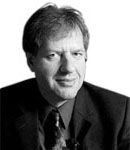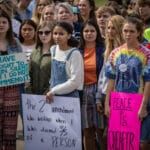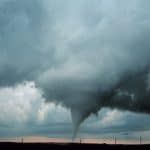A parent’s quandary
By Hugh Gusterson | February 20, 2007
When it comes to war and social issues, what do we tell the children?
“Shame on you, doing that to your child,” the jogger yelled at me as he ran past my son and I.
What had I done to my five-year-old son? Spanked him? Left him alone on the street while I
went into a store?
No. I had taken him to a protest on the National Mall against the Iraq War. As we emerged
from our local Metro station, my son was grinning and clutching an antiwar sign.
I understand where the jogger was coming from. I remember many years ago watching the
documentary
In the Nuclear Shadow: What Can the Children Tell Us? I felt uncomfortable that what the
tweens and young teens had to tell us was what they had been programmed by their antinuclear
parents to say. Let children be children, I thought to myself; let them find their own views as
they grow up.
More recently, I watched the documentary
Jesus Camp and felt a rising disgust as I watched an auditorium full of prepubescent kids
being indoctrinated on the evils of abortion, then a scene from the frontiers of homeschooling
where kids were told that the Bible settled once and for all that we did not descend from apes.
There was no pretense of exposing them to the other side of the argument. It was like watching a
Christian version of Soviet pioneer camp.
A few days before the rally against the Iraq War, thousands of protesters, many from the
Jesus Camp world, converged on the Capitol for the annual pro-life rally. Several of them
brought their children with them. I wondered if the jogger thought they should be ashamed, too.
Two weeks before the Iraq War protest, my son’s kindergarten class at the local public school
learned about Martin Luther King Jr. They were given a Martin Luther King coloring book and told
that he was a great American who made sure everyone would be treated equally. I wonder if the kids
learned about his opposition to the Vietnam War.
Before we set off for the rally, I explained to my son that the antiwar protesters would
gather where King had addressed the March on Washington.
When we got to the Mall, it was remarkable to see tens of thousands of protesters–an
enormous, jubilant sea of brightly colored humanity–stretching over several city blocks. Yet they
seemed dwarfed by the Capitol Building behind them. “This is what democracy looks like,” the
protesters were chanting. I tried to explain to my five year old what democracy was and what
happened in that magnificent white building towering over us.
My son mainly enjoyed the colorful puppets and the sporadic drumming. He was bored to
distraction by the speeches. Since he cannot read, he could not appreciate the wit of many of the
signs at the protest: “Leave no child alive,” “I refuse to fight in a war started by a man who
refused to fight in a war,” “Killing one person is murder, killing 600,000 is foreign policy,” “I’m
not disturbing the peace, I’m disturbing the war,” “Surge the twins,” “How many lives per gallon?”
“The rapture is not an exit strategy,” “At least in Vietnam Bush had an exit strategy,” “What part
of NO-vember don’t you understand?” and “They may have elected him president, but who made him
emperor?”
This is what democracy looks like.
But the sign that spoke loudest to me was not clever at all. “Schools not bombs,” it said
simply. During the last peace movement there was a popular bumper sticker that read, “It will be a
great day when our schools get all the money they need, and the air force has to hold a bake sale
to build a bomber.”
My son’s public school, just a few miles from the Capitol Building, is supposedly one of the
best public schools in Washington, D.C., but the toilets don’t work properly, the coat pegs are
falling out of the wall, and the teacher’s assistant in my son’s class quit because she was
underpaid. While the Pentagon gets $450 billion a year (with an extra $100 billion thrown in this
year for the Iraq War), parents at my son’s school sell Christmas trees in the cold rain, organize
auctions and fundraising dances after they come home from work, and beg local businesses to donate
to the school, arduously raising money dollar by dollar for books and teachers’ aides.
This is why, far from being ashamed, I felt that I was honoring my son by taking him to the
protest. And honoring Martin Luther King. He said, “A society that spends more money on military
defense than on programs of social uplift is approaching spiritual death.”
When we got home, my son insisted on putting the sign he acquired at the protest in our front
window. The words “escalation: wrong way” framed the red and white traffic symbol for “no entry.” I
asked my son what the sign meant. “It’s telling people not to park in our driveway,” he said.
Let this child be a child a little longer.
Together, we make the world safer.
The Bulletin elevates expert voices above the noise. But as an independent nonprofit organization, our operations depend on the support of readers like you. Help us continue to deliver quality journalism that holds leaders accountable. Your support of our work at any level is important. In return, we promise our coverage will be understandable, influential, vigilant, solution-oriented, and fair-minded. Together we can make a difference.
Topics: Columnists














